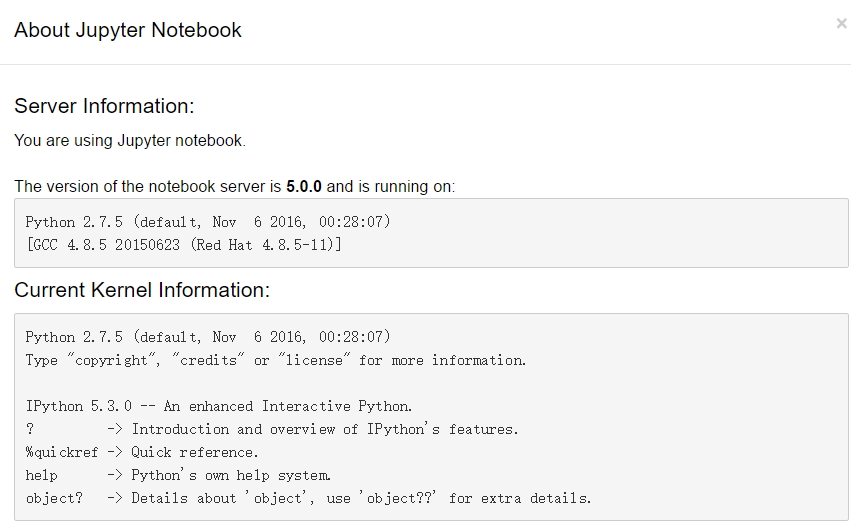centos6.4安装 jupyter-notebook
自上次发布了文章后有些网友就说不能实现效果,根据自己的实验发现确实有此事,那是因为版本的变化问题。这次基于yum仓库里的jupyter notebook 5.0.0版本实现;
系统:最小化安装[习惯性]
关闭防火墙:
- systemctl stop firewalld && systemctl disable firewalld
禁用SELINUX:
- [root@jupyter ~]# sed -i 's#SELINUX=enforcing#SELINUX=disabled#g' /etc/selinux/config
- [root@jupyter ~]# setenforce 0
添加EPLE源:
- rpm -ivh http://mirrors.yun-idc.com/epel/epel-release-latest-7.noarch.rpm
安装部分可能用到的依赖包:
- yum install vim openssl-devel readline-devel python-devel python-pip -y
Python-3.5.2 编译安装:
- tar xf Python-3.5.2.tgz
- cd Python-3.5.2
- ./configure --prefix=/usr/local/python-3.5.2
- make && make install
- #创建一个软连接:
- ln -sf /usr/local/python-3.5.2/bin/python3 /usr/bin/python3
- ln -sf /usr/local/python-3.5.2/bin/pip3 /usr/bin/pip3
这样就安装完Python3了;
#接下来安装jupyter:
- pip install jupyter //这命令默认使用的是Python2.7.5版本安装;
安装完后即可以启动:jupyter-notebook
- jupyter-notebook
如果在启动的时候提示,说明默认不建议使用root来运行,不过我们可以配置文件修改,接下来会介绍如何修改;
- [C 15:03:06.778 NotebookApp] Running as root is not recommended. Use --allow-root to bypass.
在上一次的版本中直接执行jupyter notebook --generate-config即可初始化配置文件来,但是新版的要加入--allow-root才行;
- [root@pydev ~]# jupyter notebook --generate-config --allow-root
- Writing default config to: /root/.jupyter/jupyter_notebook_config.py
创建一个密码:[这样就不用每次复制URL地址]
- [root@jupyter ~]# ipython
- Python 2.7.5 (default, Nov 6 2016, 00:28:07)
- Type "copyright", "credits" or "license" for more information.
- IPython 5.3.0 -- An enhanced Interactive Python.
- ? -> Introduction and overview of IPython's features.
- %quickref -> Quick reference.
- help -> Python's own help system.
- object? -> Details about 'object', use 'object??' for extra details.
- In [1]: from notebook.auth import passwd
- In [2]: passwd()
- Enter password:
- Verify password:
- Out[2]: 'sha1:da874cad4309:4104089e5ef97c8fcbe69c2ac7d6a1071ca50a40'
修改配置文件中的IP地址、工作目录、并添加一个认证密码:
- 62 #c.NotebookApp.allow_root = False
- 去掉62行的注释,并修改成True即可解决root权限运行的问题。
- 163 #c.NotebookApp.ip = 'localhost'
- 去掉注释,并把localhost改成0.0.0.0,这样就可以外部访问了,默认只有在本机可以访问的;
- 163 c.NotebookApp.ip = '0.0.0.0'
- 203 #c.NotebookApp.notebook_dir = u''
- 改成如下,这样就会默认把notebook上创建的文件保存到指定目录下;需要事先创建。
- 203 c.NotebookApp.notebook_dir = u'/opt/jupyter'
- 218 #c.NotebookApp.password = u''
- 加入上面创建的密码:
- 218 c.NotebookApp.password = u'sha1:da874cad4309:4104089e5ef97c8fcbe69c2ac7d6a1071ca50a40'
这里就是行号有所变化;根据关键字查询即可;
保存,重新运行程序:
- [root@jupyter~]# jupyter-notebook
- [I 15:20:53.313 NotebookApp] Serving notebooks from local directory: /opt/jupyter
- [I 15:20:53.313 NotebookApp] 0 active kernels
- [I 15:20:53.313 NotebookApp] The Jupyter Notebook is running at: http://0.0.0.0:8888/
- [I 15:20:53.313 NotebookApp] Use Control-C to stop this server and shut down all kernels (twice to skip confirmation).
- [W 15:20:53.313 NotebookApp] No web browser found: could not locate runnable browser.
URL地址:10.0.10.253:8888
密码:123456
不过在查看版本的时候还是有个问题,就是切换了python版后,使用命令还是一样显示为python2.7.5
验证:输入命令:netstat -ntlp
[root@localhost centos]$ netstat -ntlp
Active Internet connections (only servers)
Proto Recv-Q Send-Q Local Address Foreign Address State PID/Program name
tcp 0 0 0.0.0.0:111 0.0.0.0:* LISTEN 1/systemd
tcp 0 0 192.168.122.1:53 0.0.0.0:* LISTEN 1980/dnsmasq
tcp 0 0 0.0.0.0:22 0.0.0.0:* LISTEN 1598/sshd
tcp 0 0 127.0.0.1:631 0.0.0.0:* LISTEN 1601/cupsd
tcp 0 0 0.0.0.0:8888 0.0.0.0:* LISTEN 18997/python
tcp 0 0 127.0.0.1:25 0.0.0.0:* LISTEN 1874/master
tcp6 0 0 :::111 :::* LISTEN 1/systemd
tcp6 0 0 :::22 :::* LISTEN 1598/sshd
tcp6 0 0 ::1:631 :::* LISTEN 1601/cupsd
tcp6 0 0 :::8888 :::* LISTEN 18997/python
tcp6 0 0 ::1:25 :::* LISTEN 1874/master
大悲无泪--大悟无言--大笑无声





【推荐】国内首个AI IDE,深度理解中文开发场景,立即下载体验Trae
【推荐】博客园2025新款「AI繁忙」系列T恤上架,前往周边小店选购
【推荐】凌霞软件回馈社区,携手博客园推出1Panel与Halo联合会员
【推荐】轻量又高性能的 SSH 工具 IShell:AI 加持,快人一步